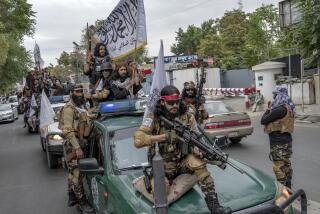Taliban border haven in U.S. sights
Reporting from Washington â U.S. military officials racing to make progress in Afghanistan are pressing new tactics to choke off the flow of Taliban fighters and bomb-making materials from Pakistan into key battlefields of the south, with some even advocating cross-border attacks, according to several U.S. civilian and military officials.
Two senior officers from the staff of Gen. David H. Petraeus, the U.S. general who commands NATO forces in Afghanistan, are scheduled to meet with Pakistani counterparts this week, a senior NATO official said, in part to present intelligence about Taliban operations in Baluchistan, a Pakistani province along Afghanistanâs southern border.
The focus on southern Afghanistan is a response to the difficulties the U.S. has encountered this year in Kandahar and neighboring Helmand province, to which the U.S. has sent tens of thousands of additional troops.
Offensives in the region, the heartland of the Taliban movement, have struggled to clear guerrilla fighters who melt into the local population. U.S. and Afghan officials have in many areas not been able to establish stable government and improve services, priorities in the effort to win the support of Afghan civilians.
Petraeus is facing a deadline from the White House to show progress in the war by July, and officials said he is pushing the Pakistani military to confront the Taliban.
âWeâre going to take this fight to the edge,â said one official. âWeâre not going to back off from the fight.â
Long a Taliban stronghold, Kandahar and areas of Helmand have remained violent in part because of the ongoing infiltration of fighters over the border. The Taliban leadership fled across the border into the Baluchistan capital, Quetta, after the U.S.-led invasion of Afghanistan in 2001, and some members are believed to be directing the insurgency from there.
Maj. Gen. Mike Flynn and Maj. Gen. William Mayville plan to share U.S. intelligence about Taliban efforts to recruit fighters in refugee camps in Pakistan and locations where the militant group loads ammonium nitrate, a key chemical in homemade bombs, to be smuggled over the border, officials said.
The goal, U.S. officials said, is to persuade the Pakistani military to crack down on these activities.
Some steps to secure Kandahar are already underway, including the use of reconnaissance drones along the border to increase surveillance of smuggling routes and efforts to crack down on corruption. Officials say they are improving training and pay for Afghan border guards, and installing screening devices along the frontier to examine shipments.
The majority of U.S. casualties this year have been in the south. A total of 575 U.S. and allied troops have been killed this year, according to the website icasualties.org. That is the highest yearly number on record for the war, with more than two months to go. The website does not break this yearâs casualties down by location.
U.S. officials say they have begun to see a reduction in homemade bombs in southern Afghanistan, a sign that their efforts might be working.
But other U.S. military officials say that lasting stability in southern Afghanistan is impossible as long as the Taliban can operate with relative freedom in Baluchistan. Some U.S. military personnel involved in the debate are skeptical that even high-level U.S. pressure on Pakistan will produce results.
Some U.S. officials say Islamabad has long refused to take decisive action against the Taliban leadership. For that reason, they argue, unilateral U.S. operations in Baluchistan should be considered, including airstrikes or secret raids by special operations forces.
Even small-scale operations by U.S. special forces into Pakistan, unless conducted jointly with Pakistani forces, would infuriate officials in Islamabad and probably provoke a backlash even worse than that seen earlier this month, when Pakistan closed a key border crossing to North Atlantic Treaty Organization supply convoys for 11 days after a U.S. helicopter attack killed two Pakistani border guards.
Military officials said the recent rash of border incidents involving U.S. helicopters crossing into Pakistani territory and the escalation of CIA drone strikes in Pakistanâs North Waziristan region were not directly related to the debate about additional military steps in the south.
Pakistan points to its offensives last year in the Swat Valley, South Waziristan and other tribal areas in the western part of the country as proof that it is serious about taking on the Pakistani Taliban. But it says its military is stretched and cannot do more.
Most U.S. efforts to disrupt insurgent activity in Pakistan also have been farther north, in the lawless tribal areas.
Airstrikes by unmanned drones operated by the CIA have been carried out almost exclusively in the tribal areas, with tacit support and even secret assistance from the Pakistani government. In addition, most of the incidents in which U.S. forces fired into Pakistan or crossed the border while pursuing insurgents have come in the tribal regions.
Pakistani sensitivities about Baluchistan are more acute than those about the tribal belt, and officials played down the possibility that Petraeus would approve cross-border attacks in the south â even as they acknowledged that some military officers are promoting the idea.
âI suspect there probably are advocates for putting more pressure on Pakistan, who feel they have been given enough time to act,â said the senior NATO official. âBut I would tell you that at senior levels that is not under consideration.â
Senior Obama administration officials also have not approved broadening the attacks beyond the tribal belt, and the military personnel who agreed to discuss the ongoing debate would do so only anonymously because of the sensitive nature of the deliberations.
They stressed that the idea remains controversial even among U.S. commanders in Kabul, the Afghan capital, with some advocating the move out of frustration that the Pakistani military has refused to move against bomb-making facilities and refugee camps the Taliban uses for recruitment.
More to Read
Sign up for Essential California
The most important California stories and recommendations in your inbox every morning.
You may occasionally receive promotional content from the Los Angeles Times.











